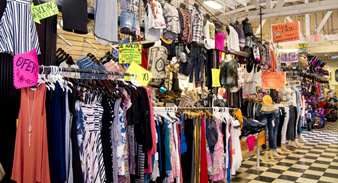Given that 1979, El Faro Plaza has actually ended up being Los Angeles's premiere indoor market, including over 250 vendors, crafters, artists from all over the world, a true mix of Angelenos. This indoor swap meet, situated in Los Angeles, is a one-stop shopping center using a wide array of stores, food suppliers, and entertainment for the whole household. And all at a fantastic rate! From foot massages to automobile window tinting, from lingerie to quinceanera gowns, from exotic birds to tvs, we have everything under one giant roof.An indoor swap meet in the United States, especially Southern California and Nevada, is a kind of exchange, an irreversible, indoor shopping mall open during regular retail hours, with fixed cubicles or shops for the vendors.Indoor swap meets home suppliers that sell a wide array of goods and services, specifically clothing and electronic devices. For example, suppliers in the Fantastic Indoor Flea Market in Las Vegas sell
clothes, furniture, bags and toys, ... but there's a heap more: flowers and plants, animal products, leather products, sporting devices, fragrance and cosmetics, luggage and electronic devices, to name simply a few. There likewise are booths for services, consisting of window tinting, palm reading, alterations, inscribing and estate planning. Most swap meet in los angeles of items offered here are new, although antique street does feature some vintage and pre-owned products. It is various in format to an outdoor swap meet, the equivalent of a flea market, usually open on a restricted variety of days and frequently without repaired places for its suppliers.

Indoor swap meets are present in lots of working-class communities throughout Southern California, with a concentration in Central Los Angeles. Indoor swap meets include the Anaheim Market, Fantastic Indoor Swap Meet in Las Vegas, and the High Desert Indoor Flea Market in Victorville. [5] Longstanding indoor swap meets that are now defunct include the Pico Rivera Indoor Flea Market [6] and San Ysidro Indoor Swap Meet.Swap satisfies in the U.S. long included U.S.-born vendors who offered mostly previously owned goods in outside spaces. In the 1970s, Latino immigrants began selling cultural products and affordable services at swap meets in Southern California and some swap meets begun resembling the tianguis, al fresco markets, of Mexico. At the same time, drive-in movie theaters were becoming less popular, and their owners eagerly leased them out during the day to outside swap meets, which proliferated. Then, primarily Korean immigrants used their connections in the growing import/export trade with Asia to establish their own swap meet stalls and stock them with new, low-cost products from Asia instead of previously owned goods. In the 1980s and 1990s as homes South Los Angeles and parts of Central L.A. became deserted and thus, inexpensive, Korean immigrants purchased them and turned them into indoor swap meets.